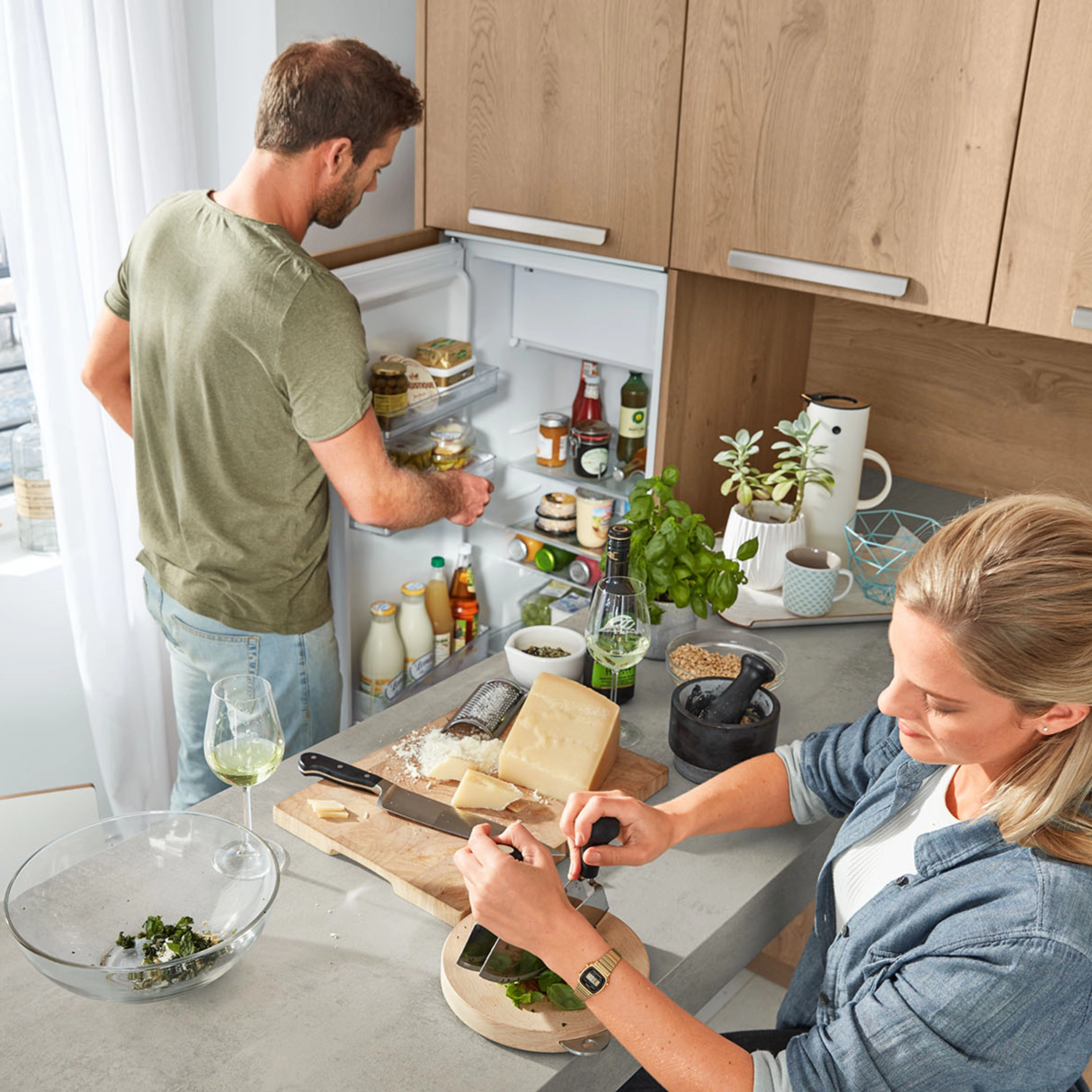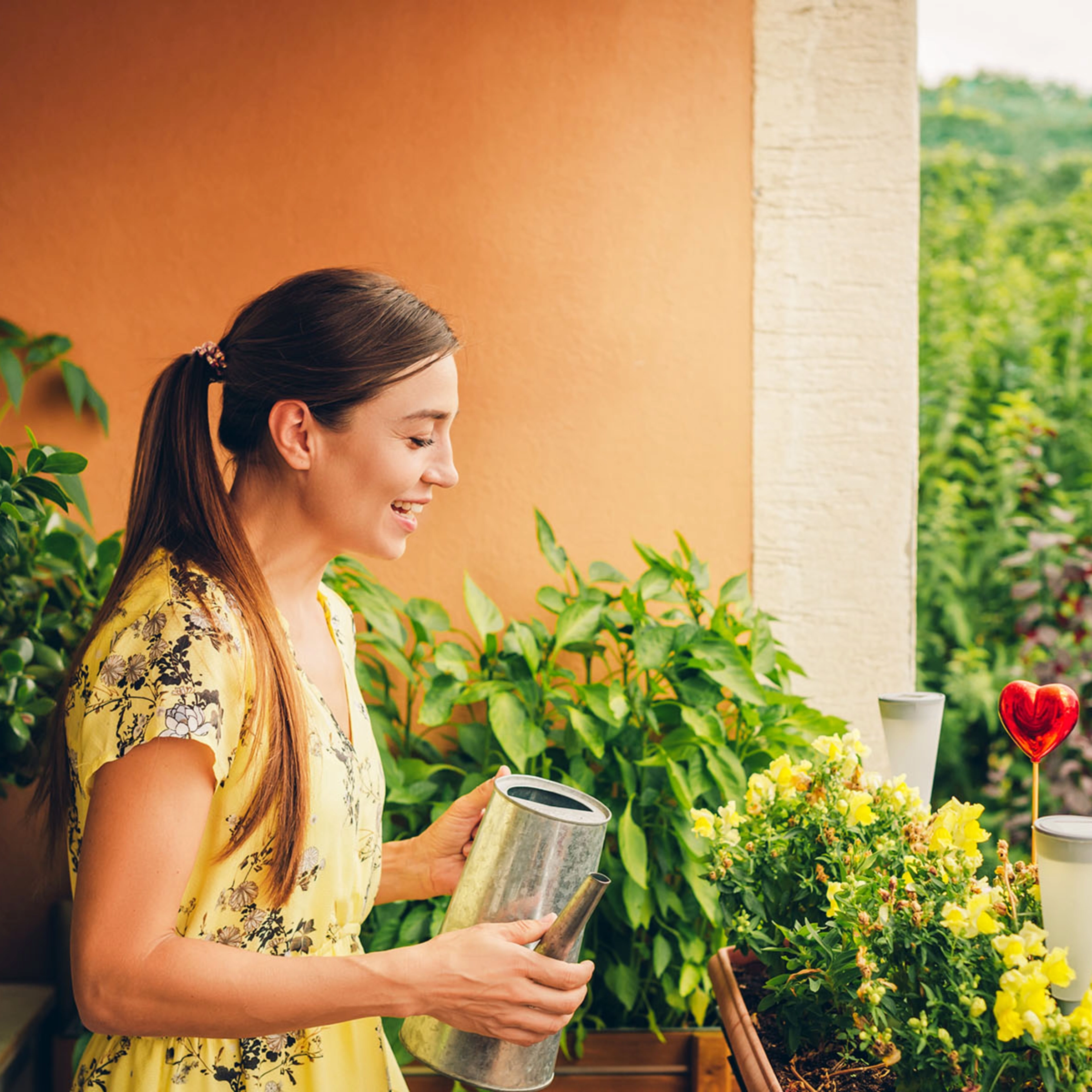Sustainability in the kitchen

The careful handling of natural resources and awareness of our environment are becoming increasingly crucial. A sustainable way of life benefits our environment and thus future generations. As the heart of our personal living space, our kitchen offers plenty of room and various opportunities for sustainable and environmentally friendly design. However, sustainability in the kitchen does not just mean relying on environmentally friendly kitchen appliances and energy-saving methods. There are several other aspects that play an important role when creating a sustainable kitchen. Which aspects these are and what you can specifically do to bring sustainability into your kitchen, you will find out in the 10 following tips.
Why sustainability in the kitchen can make a big difference
The kitchen table and counter are often the heart of our home. We spend a lot of time here. We eat, cook, do homework, read newspapers, play, do arts and crafts, celebrate and thus spend a lot of shared time here. Our kitchen is a place where life happens – and unfortunately also where much consumption or waste occurs.
Cooking creates a lot of waste and often uses excessive amounts of water, electricity and plastic. To reduce this significant environmental impact and conserve valuable resources, sustainability in the kitchen is becoming increasingly important.
If you make your kitchen sustainable, you
- automatically reduce your ecological footprint,
- save money through a few simple measures,
- can spend your valuable saved time on other things,
- and feel good because you've made our planet a little bit better.
Sustainability begins in the kitchen. The following 10 tips will help you make your kitchen more environmentally friendly and resource-efficient.

Tip 1:
Use local and seasonal ingredients
Fresh fruits and vegetables from the region are highly recommended for a healthy and sustainable diet.
The shorter the distance the food has to travel, the better it is for the environment. Consequently, regional products incur fewer transportation costs and less packaging is needed. Complex manufacturing, disposal, and the topic of packaging recycling can thus be avoided. On one hand, this protects the environment. On the other hand, regional products generally exhibit a significantly better CO2 footprint.
Regional and seasonal vegetables also frequently score better in terms of taste. This is because products from the region are able to fully ripen and don't have to embark unripe on a long journey. Hence, ripe and delicious food ends up in your fridge or kitchen drawer, rather than hard and less flavorful alternatives.

Tip 2:
Avoid waste through targeted planning and storage
Directly connected to the topic of sustainability is waste avoidance. Ideally, buy only what you can actually store to prevent unnecessary disposal. Targeted shopping and menu planning, along with maintaining a shopping list, will help you buy only what you can entirely use afterwards.
And if there is something left over, the internet offers numerous recipe ideas for using up leftover food. Consider also that some items can still be consumed long after the expiration date. Assess these items less by their expiration date and more by their appearance and smell.
How you store your food also plays an important role. Replace cling film and aluminum foil with a lunch box or glass container. These can be washed and reused.
The topic of organic waste is also an important aspect of a sustainable kitchen: Some people pack their organic waste in plastic bags to throw them into the container afterwards. This is a fatal decision, as the fact is that these cannot decompose and must be removed at the composting plant. It is better to switch to paper bags or ideally dispose of your compost completely loose.

Tip 3:
Choosing sustainable kitchen utensils
Sustainable kitchen utensils are utensils made from environmentally friendly materials and designed to be durable and produce as little waste as possible.
The following materials are particularly suitable for sustainable kitchen utensils:
- Wood
- Bamboo
- Stainless steel
- Glass
- Beeswax
- Silicone
By using sustainable kitchen utensils, you can help reduce waste and protect the environment.

Tip 4:
Use energy-efficient appliances and renewable energy sources
A sustainable kitchen should be designed to consume as little energy as possible and use renewable energy sources to meet energy needs. Here are several ways you can make your kitchen more energy-efficient:
- Energy-saving appliances: Use energy-saving appliances such as induction cooktops, refrigeration and freezing units with high energy efficiency ratings, and water-saving dishwashers to reduce energy consumption in the kitchen.
- Renewable energy sources: Use renewable energy sources such as solar power or wind energy to power your kitchen. Install solar panels on the roof of your house or obtain green electricity from a provider that uses renewable energy sources.
- LED lighting: Use energy-efficient LED lights in your kitchen to reduce electricity consumption.
- Insulation: Ensure your kitchen is well-insulated to reduce energy consumption for heating and cooling.
- Cooking habits: Use cooking methods that consume little energy, such as steaming or cooking on a stove with a low setting.
- Composting: Compost organic kitchen waste to reduce waste and fertilize your garden or plants.

If you use energy-saving appliances and renewable energy sources and pay attention to sustainable cooking practices, you can make your kitchen more energy-efficient and environmentally friendly.
Indicators for environmentally-friendly kitchen appliances:
- high energy efficiency classes A and B
- Longevity
- Eco-Programme
- recyclable materials
- efficient insulation
- smart control and monitoring via App
- production runs on green electricity
Tip 5:
Use biodegradable cleaning agents
Sustainable kitchens should also be cleaned with biodegradable cleaning agents to reduce environmental impact. Here are some examples of biodegradable cleaning agents:
- Vinegar is an effective cleaning agent that can be used in many areas of the kitchen. Mix vinegar with water and use it as an all-purpose cleaner or as a cleaning agent for windows and mirrors.
- Lemon juice is a natural bleaching agent and can be used to remove stains and discolorations. Mix lemon juice with water and use it as a cleaning agent for kitchen countertops or as an odor neutralizer.
- Baking powder can be used as a scouring agent to remove greasy residues or encrustations. Mix baking powder with water and use it as a cleaning agent for ovens or as a scouring agent for pots and pans.
- Baking soda can be used as an odor neutralizer and can help remove odors from the kitchen. Sprinkle some baking soda on the bottom of the refrigerator or trash can to eliminate unpleasant odors.
- Essential oils can be used as fragrances to create a pleasant atmosphere in the kitchen. Add a few drops of essential oil to your homemade cleaning agent to produce a fresh fragrance.
- Bio-cleaning agents: There are also special bio-cleaning agents available on the market, which are manufactured from natural ingredients and are biodegradable. When purchasing cleaning agents, pay attention to the ingredients and choose products that are environmentally friendly.

Tip 6:
Avoid plastic packaging and containers
A sustainable kitchen should avoid plastic to reduce environmental impact.
Ideally, you should completely avoid plastic containers and prioritize stainless steel and glass containers for storing or transporting foods. Such containers are durable and can be reused repeatedly.
Reusable cloth bags are also an excellent choice to avoid plastic bags. You can also use reusable mesh (net-like material) bags to store fruits and vegetables.
Beeswax wraps are very suitable for packing or covering food, instead of using plastic wrap or aluminum foil. They are reusable, biodegradable, and thus an excellent and sustainable alternative.
Avoid single-use plastic bottles and instead use reusable bottles made of glass or stainless steel. There are also reusable drinking bottles made of BPA-free plastic available on the market.

Tip 6:
Avoid plastic packaging and containers
Water is a valuable resource that we use, among other things, for food preparation and cleaning in the kitchen.
With the following 5 tips, you can save water in your kitchen:
- Use the dishwasher: A dishwasher can be more efficient than washing dishes by hand and can save water.
- Use a water-saving faucet: A water-saving faucet can reduce water consumption by up to 50%.
- Avoid unnecessary rinsing: Rinse only when it is truly necessary and avoid unnecessary rinsing.
- Use a bucket for rinsing: Use a bucket to catch rinse water instead of leaving the water running. The collected water can be reused for other purposes.
- Always use a lid when cooking: A lid on the pot or pan can help reduce water consumption when cooking.

Tip 8:
Create a herb garden in the kitchen or on the balcony
Having your own herb garden on the balcony or in the kitchen not only offers the advantage of always having your favorite herbs at hand and thus saving costs. Usually, self-planted herbs also taste much more intense and are free of pesticides and other substances, making them often healthier.
An own herb garden can also help reduce environmental impact, as no packaging, transport distances, or chemical substances for preserving herbs are necessary.
Overall, an own herb garden provides many benefits, from freshness and health to sustainability, versatility, and relaxation while planting. It is a great way to enrich your sustainable kitchen and to connect with nature.

Tip 9:
Rely on sustainable kitchen furniture and kitchen designs
Sustainable kitchen furniture is usually made from environmentally friendly materials that require less energy and resources. This reduces the environmental impact and minimizes the carbon footprint.
They are generally free from harmful substances such as formaldehyde, VOCs (volatile organic compounds) and other harmful chemicals. In this way, they can help improve indoor air quality and create a healthier living climate.
Sustainable kitchen furniture is moreover often made from high-quality materials that last longer and are less susceptible to damage or wear. This reduces the need to replace furniture frequently, thereby again reducing environmental impact.
Additionally, sustainable kitchen furniture is often available in appealing designs and styles that are both functional and aesthetically pleasing. They thus represent a good opportunity to combine environmentally friendly and attractive furniture.
Sustainable kitchen furniture is definitely a sensible choice that can help reduce environmental impacts, create healthier living conditions, increase longevity, while also offering stylish and attractive furniture.

Tip 10:
Support companies that follow sustainable practices
Sustainable companies are those companies that act responsibly and environmentally friendly with regard to the quality of life for current and future generations. There are many sustainable companies in Europe that focus on various industries and business sectors. Some of them can also help you bring more sustainability into your kitchen, such as these three:
- Unilever (Herstellung von Lebensmitteln, Getränken, Haushalts- und Körperpflegeprodukten)
- Interface (Herstellung von nachhaltigen Teppichen und Bodenbelägen)
- Ecover (Herstellung von umweltfreundlichen Reinigungs- und Waschmitteln)
At Nolte Küchen, we have also been addressing the topic of sustainability for a long time.
These are just a few examples of sustainable companies in Europe. There are many other companies that engage in sustainability and social responsibility, offering products and services that reduce environmental impact and improve quality of life.

Sustainability begins in your own kitchen

A sustainable kitchen includes, among other things
- the use of energy-saving devices
- the use of renewable energy sources
- the avoidance of plastic
- the use of biodegradable cleaning agents
Growing your own herbs and vegetables, as well as purchasing regional and seasonal products, also contribute to sustainability in the kitchen. There are several environmentally conscious companies in Europe committed to sustainability and social responsibility, offering products and services that reduce environmental impact and improve quality of life.
Everyone can contribute to creating a sustainable kitchen and thereby have a positive impact on the environment and the future.
Further sources on the topic “Sustainability in the Kitchen”
If you would like to delve even deeper into the topic of "Sustainability in the kitchen" and create more sustainable eating habits, we recommend the following 3 sources to expand your knowledge:
- Our Nolte Blog: Here we regularly provide you with up-to-date information and tips on how you can make your kitchen and habits more sustainable.
- "Nachhaltig kochen und essen" by Petra Wenzel and Monika Götze: The book offers practical advice on sustainable meal preparation and food shopping, and also introduces sustainable kitchen utensils and cleaning products.
- "Green Kitchen at Home" by David Frenkiel and Luise Vindahl: The book offers recipes for healthy, sustainable meals based on seasonal and regional ingredients. It also provides tips on sustainable kitchen organization and avoiding food waste.
We wish you much enjoyment and success in creating your sustainable kitchen!




























